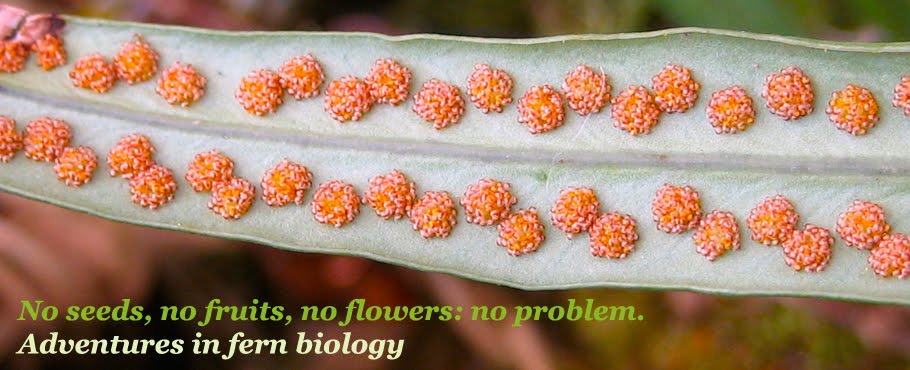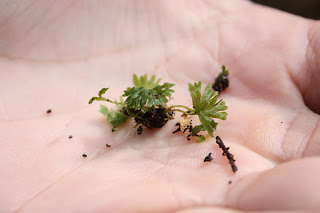In keeping with my trend of decreasing in size with these fern posts, this last one focuses on the truly tiny: gametophytes that we found growing on moist soil banks. Gametophytes are the free-living haploid stage of the fern life cycle, and in temperate climates they're usually pretty challenging to locate, since they're small, relatively ephemeral, and look just like mosses. In the tropics it's considerable easier to find them, and as soon as we started to hunt for them they started to pop out of the background. The photo above shows a large clump of gametophytes that may actually a single plant, or a bunch clumped together. That's a bit of moss sticking out of the back, not a sporophyte. The two photos below do show sporophytes starting to grow out of the gametophytes; in the first one the sporophyte is pretty small, and the large, heart-shaped plate-like structure below it is the gametophyte. In the second, the sporophytes are becoming more branched and the gametophyte is harder to make out in all the green, but it's still there!
Monday, August 22, 2011
Wednesday, August 17, 2011
Australian ferns: part II
This second installment on Australian ferns focuses on more diminutive specimens (except for the tree ferns above), including some gorgeous filmy ferns (family Hymenophyllaceae) that we found growing in a probably perpetually-moist splash area around a culvert.
Monday, August 15, 2011
Australia ferns: part I
You may have noticed a distinct lack of ferns in the last few, Australia posts... that's because I've been saving the best for last! We did indeed see lots of ferns Down Under, though unfortunately I know very few of their names. All of these photos were taken in the various eucalypt forests we drove through, and there will be three of these fern-centric posts to round out my series on this summer's Australian adventures.
This is a tree-fern stump that was burned in the recent, awful fires that consumed thousands of acres around Marysville in January 2009. This fern didn't survive, but the vascular structure that remains inside the trunk is beautiful.
Friday, August 12, 2011
Little Desert National Park
Our drive through Victoria culminated with a visit to the Little Desert National Park, which is at the extreme eastern edge of the state, where it borders South Australia. This is the beginning of the outback, and the vegetation is appropriately scruffy, though with beautiful flowering things if you were careful to look for them...
Monday, August 8, 2011
Eucalypts
We spent the next day driving through some beautiful, pristine eucalypt forests in central Victoria. Eucalyptus is definitely the defining Australian tree genus; there are more than 700 species found on the continent, and many forests, like the ones we drove through, are dominated by eucalypts. We also visited the tallest one in the world (well, maybe - it apparently has competition from a tree in New Zealand). There are some tree ferns around as well... in fact in some places they create a secondary canopy lower to the ground, below the eucalypts and taller trees.
Thursday, August 4, 2011
Cranbourne Botanic Gardens
Well, my trip to Australia has come and gone, and now all that's left is to sort through the photos and decide which ones to post! The next few weeks here will likely be devoted to cataloguing the places we went and the plants we saw.
Following the International Botanical Congress in Melbourne, my advisor led my lab on a three-day driving trip around much of Victoria, Australia. We started off at a second botanical garden (we are botanists, after all!) about an hour from Melbourne, called the Cranbourne Royal Botanic Gardens. They had a gorgeous collection of acacias and eucalypts, against a red-soil background that is characteristic of the outback parts of Victoria, which weren't far in our future...
Subscribe to:
Comments (Atom)














































